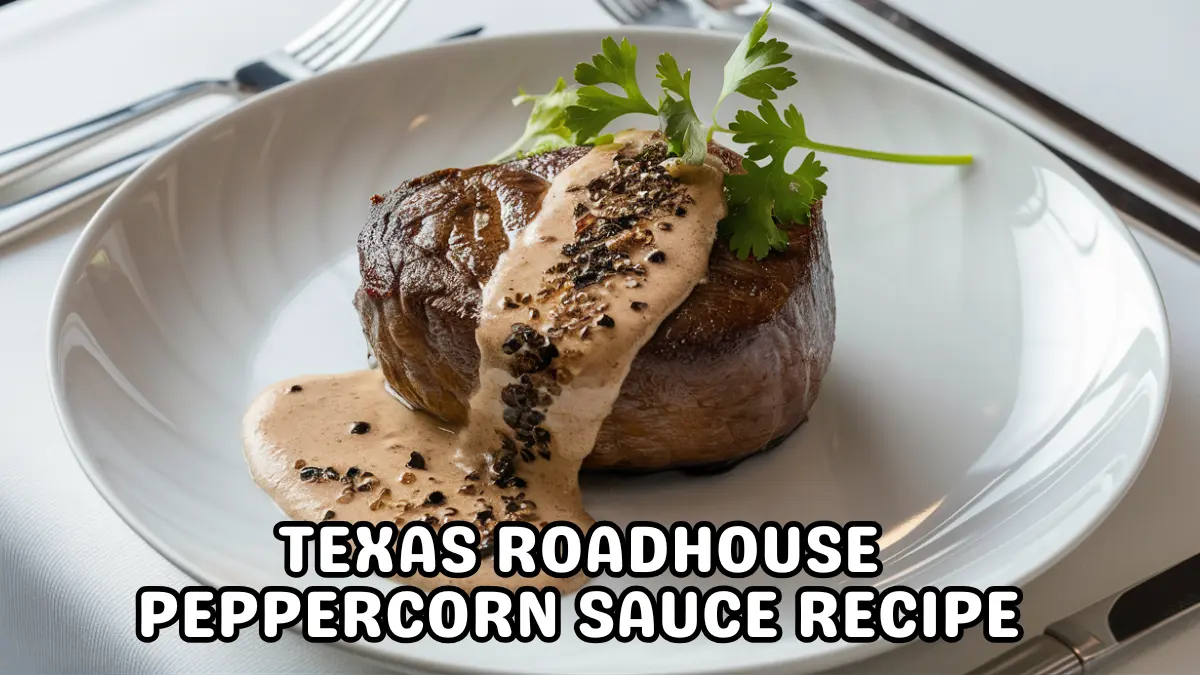Texas Roadhouse White Gravy is more than just a sauce—it’s the heart of Southern comfort food. Rich, creamy, and full of flavor, this homestyle gravy is what makes biscuits, chicken-fried, and mashed potatoes truly unforgettable.
Made from simple ingredients like bacon grease, flour, and milk, this gravy delivers the perfect balance of smoothness and seasoning. Every spoonful brings a taste of down-home cooking, the kind that feels warm and familiar.
If you’ve ever wanted to recreate that signature Texas Roadhouse flavor in your own kitchen, this recipe will show you how. Follow these easy steps to make a creamy, peppery white gravy that tastes just like the real thing.

What’s the Difference Between Gravy and White Gravy?
- Traditional brown gravy: Made from meat drippings (like beef or turkey), thickened with flour or cornstarch, and often served with mashed potatoes or roasts.
- White gravy: Made with milk or cream instead of meat drippings. It’s creamy, rich, and often served with biscuits, chicken-fried steak, or fried chicken.
Possible Substitutions for This Recipe
- Instead of bacon grease: You can use butter, vegetable oil, or even chicken fat (schmaltz). Each will give a slightly different flavor, but all will work to make a good gravy.
- Instead of all-purpose flour: Gluten-free flour blend works for those with gluten sensitivities. You can also use cornstarch (use half the amount), but the texture will be a bit different.
- Instead of whole milk: Half-and-half or heavy cream will make an even richer gravy. For a lighter version, 2% milk works fine. In a pinch, you can use canned evaporated milk like they do on ranches.
- Instead of water: Low-sodium chicken broth can add extra flavor if you need to thin your gravy.
What is Roadhouse White Gravy Made of?
- Butter: 4 tablespoons. This will provide the base flavor and richness.
- Flour: 1/4 cup. Used to thicken the gravy.
- Milk: 2 cups. You can use whole milk for a creamier texture or low-fat milk if you prefer.
- Salt: 1/2 teaspoon. Adjust to taste.
- Black Pepper: 1/2 teaspoon. Freshly ground is best for flavor.
- Bacon Grease: If you want an authentic Southern flavor, use about 1/4 cup of bacon grease instead of some of the butter (Optional).
Possible Substitutions for This Recipe
- Instead of bacon grease – Use butter, vegetable oil, or even chicken fat (schmaltz). Each will give a slightly different flavor but will still make a delicious gravy.
- Instead of all-purpose flour – A gluten-free flour blend works for those with gluten sensitivities. You can also use cornstarch (use half the amount), but the texture will be slightly different.
- Instead of whole milk – Half-and-half or heavy cream will create a richer gravy. For a lighter version, 2% milk works fine. In a pinch, you can use canned evaporated milk like they do on ranches.
- Instead of water – Low-sodium chicken broth can add extra flavor if you need to thin your gravy.
- Instead of black pepper – White pepper can be used for a slightly different spice profile.
Kitchen Appliances Needed
Medium saucepan: For melting butter and cooking the roux.
Whisk: To mix the flour and butter smoothly and prevent lumps.
Spatula: Helpful for scraping the sides of the pan and stirring the gravy.
How to Make Texas Roadhouse White Gravy
Step 1 | Melt the Butter
Place a medium saucepan over medium heat and add the butter. If using bacon grease, add it now. Let it melt completely.
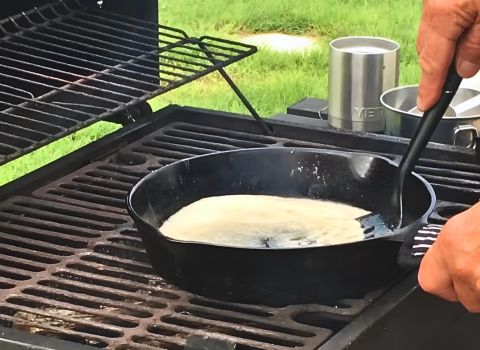
Step 2 | Create the Roux
Once the butter is melted, add the flour. Whisk constantly until the mixture is smooth and forms a light brown paste. This should take about a minute.

Step 3 | Add Milk
Gradually pour in the milk, whisking continuously to avoid lumps. If the mixture starts to thicken too quickly, you can add a little cold water to slow it down.
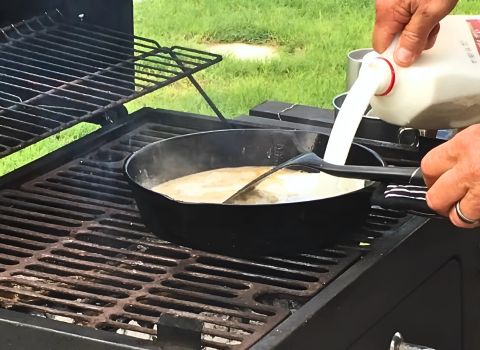
Step 4 | Bring to a Simmer
Increase the heat slightly until the gravy starts to simmer. You’ll see bubbles forming around the edges of the pan.
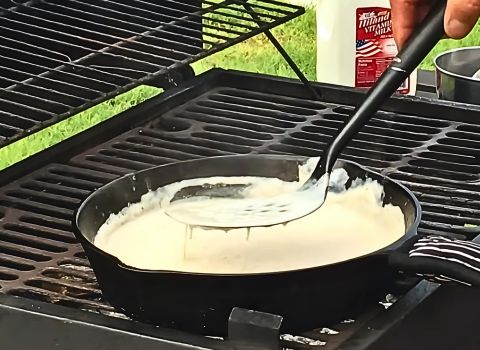
Step 5 | Thicken the Gravy
Reduce the heat to low and let the gravy simmer for about 5 minutes, or until it reaches your desired consistency. Stir frequently to prevent scorching.
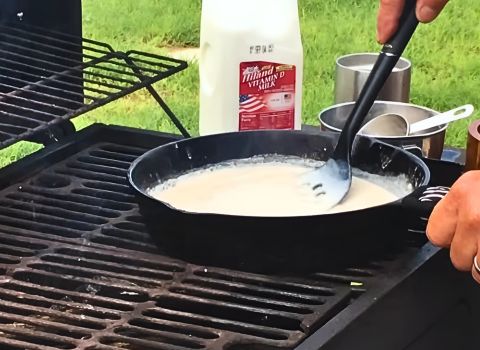
Step 6 | Season and Serve
Add salt and pepper to taste. You can adjust the seasoning right before serving. Pour the warm gravy over your favorite dishes, such as fried chicken, chicken fried steak, or biscuits.
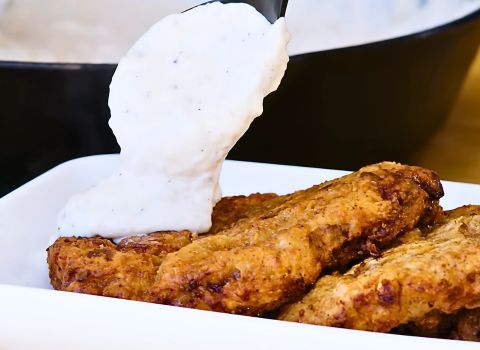
Tips for Making the Best White Gravy
- Watch the heat – Too hot and your gravy will scorch; too cool and it won’t thicken properly.
- Never stop stirring – Constant motion prevents lumps and burning.
- Trust your eyes and instincts – The gravy should “flow like lava” – not too thick, not too thin.
- If lumps form – Use a whisk to beat them out, or in worst cases, strain the gravy through a fine mesh sieve.
- Let it rest briefly – Gravy will continue to thicken slightly after you remove it from heat.
- If it gets too thick – Add a splash of warm milk to thin it out.
- If it’s too thin – Mix a teaspoon of flour with cold water, then stir this slurry into the gravy.
What Goes Good with Roadhouse Cream Gravy?
- Buttermilk Biscuits – The classic Southern combination for a hearty breakfast.
- Chicken-Fried Steak – A Texas favorite that wouldn’t be the same without creamy white gravy.
- Mashed Potatoes – Rich and creamy gravy enhances the smoothness of mashed potatoes.
- Crispy Fried Chicken – Drizzle the gravy over fried chicken for an extra layer of comfort.
- Country-Style Pork Chops – A savory pairing that brings out the best in the meat.
- Homemade Meatloaf – White gravy can be an unexpected but delicious alternative to brown gravy on meatloaf.
- Sautéed Vegetables – Use it as a dip or drizzle over green beans, corn, or roasted veggies.
White Gravy Storing and Reheating Process
Storing:
- Let the gravy cool completely before transferring it to a container.
- Store in an airtight container in the refrigerator for up to 3 days.
Stovetop Reheating Method:
- Place the chilled gravy in a saucepan over low heat to prevent scorching.
- Stir continuously to maintain a smooth texture.
- If the gravy is too thick, add a splash of warm milk or water to thin it out.
Microwave Reheating Method:
- Heat in short intervals (30 seconds), stirring in between to prevent lumps.
- Avoid overheating, as it can cause the gravy to separate or become too thick.
Texas Roadhouse White Gravy Recipe FAQs
1. My Texas Roadhouse white gravy got lumpy. How can I fix it?
If your gravy gets lumpy, don’t panic! Try whisking it vigorously with a wire whisk to break up the lumps. If that doesn’t work, you can pour the gravy through a fine-mesh strainer to catch the lumps.
To prevent lumps in the first place, make sure to keep stirring constantly, especially when adding the milk, and try warming your milk before adding it to the hot roux.
2. How thick should Texas Roadhouse white gravy be?
Authentic Texas Roadhouse white gravy should be thick enough to coat the back of a spoon but still pourable – not runny like water or stiff like pudding. As our recipe mentions, it should “stay on the biscuit” but still flow nicely.
If your gravy is too thick, add a little more warm milk. If it’s too thin, let it cook longer to reduce, or mix a little flour with cold water and stir this mixture into the gravy.
3. Can I make Texas Roadhouse white gravy ahead of time for my family gathering?
Yes! You can make the gravy up to 2 days ahead and store it in the refrigerator in an airtight container. It will thicken considerably when cold. When ready to serve, reheat it slowly on the stovetop over low heat, stirring constantly.
You’ll need to add some milk (about 2-4 tablespoons per cup of gravy) to thin it back to the right consistency. For best taste and texture, warm it up just before serving.
4. Why does my white gravy sometimes separate or look oily when reheated?
Separation happens when the fat breaks away from the other ingredients, usually due to overheating or rapid temperature changes. To prevent this, always reheat Texas Roadhouse white gravy slowly over low heat, stirring constantly.
If your gravy does separate, try taking it off the heat and whisking vigorously to bring it back together. Adding a splash of warm milk while whisking can also help restore its creamy texture.
5. My gravy tastes too floury. What did I do wrong with the Texas Roadhouse recipe?
A floury taste means the flour in your roux didn’t cook long enough before adding the milk. When making the recipe, be sure to cook the flour and bacon grease mixture for at least 2-3 minutes until it bubbles and smells slightly nutty, not raw.
This cooking step is crucial for good flavor. If you’ve already added the milk and it tastes floury, try cooking the gravy a bit longer and adding a little more black pepper to help mask the taste.
[mv_create key=”88″ thumbnail=”https://winkrecipe.com/wp-content/uploads/2025/03/Texas-Roadhouse-White-Gravy-Recipe.webp” title=”Texas Roadhouse White Gravy Recipe” type=”recipe”]
Conclusion
Making Texas Roadhouse White Gravy at home is easier than you think, and the best part is that you can enjoy that rich, creamy, and comforting taste anytime! Whether you’re drizzling it over fluffy biscuits, crispy fried chicken, or a hearty country-fried steak, this homemade gravy is sure to bring warmth to your table.
Now that you have all the steps and tips, why not give it a try? Nothing beats homemade comfort food made with love. If you make this recipe, we’d love to hear how it turned out! Share your experience with us, and don’t forget to follow us on Pinterest for more delicious recipes straight from the heart of Southern cooking.





